I especially enjoy learning about the relationships between evolution, ecology and ethology, so I was thrilled when I stumbled across a really sweet scientific paper the other day. This paper investigates the relationship between environment and behaviour in a butterfly.
 Adult
butterflies are highly visual animals, relying on their keen eyesight
to locate and identify appropriate mates by looking at and comparing
their wing colours and patterns. Many butterflies show variations in
wing colours and patterns depending upon the season they experienced as
caterpillars or whilst cocooning. Knowing this, it is reasonable to
assume that differences in wing colours and patterns (known as polyphenisms)
could affect how adult butterflies interact with each other. But do
wing polyphenisms affect adult butterfly behaviours? If so, how?
Adult
butterflies are highly visual animals, relying on their keen eyesight
to locate and identify appropriate mates by looking at and comparing
their wing colours and patterns. Many butterflies show variations in
wing colours and patterns depending upon the season they experienced as
caterpillars or whilst cocooning. Knowing this, it is reasonable to
assume that differences in wing colours and patterns (known as polyphenisms)
could affect how adult butterflies interact with each other. But do
wing polyphenisms affect adult butterfly behaviours? If so, how?
Dr Katy Prudic, and her postdoctoral advisor, Dr Antónia Monteiro, researchers in the Department of Ecology & Evolutionary Biology at Yale University, investigated the relationship between the environment and behaviour in the east African butterfly species, the squinting bush brown butterfly, Bicyclus anynana.
"[It's] not particularly beautiful as compared to Morphos or monarchs, but [it is] subtly enchanting," said Dr Prudic about the butterfly in an email message.
B. anynana is very popular among researchers because it has adapted well to captivity, and it consistently shows recognizable responses to its environment. Captive animals react the same way to environmental conditions in the laboratory as wild butterflies do to local seasonal conditions, so scientists can study a variety of responses, ranging from changes in gene expression patterns and concentrations in circulating hormones to differences in wing colour patterns and behaviour.
"This butterfly is an emerging model system in evolution and development. It's been in the lab for almost 30 years, thanks to Paul Brakefield," explained Dr Prudic.
Even though this butterfly species has been bred and raised in captivity for 30 years, Dr Prudic was the first person to notice that female B. anynana appeared to be colour-coded according to season. When the adult butterfly holds its wings closed, as when perched on a flower, the exposed dorsal wing surfaces show distinct seasonal differences: adult butterflies that experienced a wet warm season (WS) as caterpillars have brighter and more numerous eyespots (figure 1A) than those seen in the cooler dry season (DS) form (figure 1B):
Interestingly, even though the size and number of eyespots on the dorsal wing surface are different between the colourful WS and paler DS forms, males and females of both forms have two eyespots on both surfaces of their forewings that remain unchanged regardless of environment (compare WS female [figure 1C] to WS male [figure 1D] and to DS female [figure 1E] and DS male [figure 1F]).
Knowing that butterflies are highly visual, and that this species attracts its mates with a ritualized courtship dance, Dr Prudic wanted to know if courtship behaviours differed between the two forms. As you can see in this video (below), courtship in this butterfly species involves an individual "dancing" by rapidly flashing its wings in front of the eyes of its intended mate:
But what aspect of this dance is the watching butterfly actually responding to? To untangle the effects of courtship dancing behaviours from each other, Dr Prudic designed a series experiments to observe and quantify these behaviours for both sexes and both seasonal forms of this butterfly. First, she wanted to know which sex in each form did most of the dancing (figure 2):
Dr Prudic found that the paler DS females courted males of either form more often than did the colourful WS females (figure 2A). She also found that environment affected male courtship dancing: the more colourful WS males courted females more often than did the paler DS males (figure 2B). When courtship frequency shown by males and females of the same form were compared, Dr Prudic's team found that WS males courted more frequently than WS females, whereas DS females courted more than DS males.
But what visual cue are the dancing butterflies providing to the observing butterflies? In view of the fact that WS males are much brighter than DS females, yet both have a high frequency of courtship dancing, Dr Prudic thought there must be another visual cue (other than colourful wings) that the prospective mates are looking at -- something that doesn't vary with season. After watching the dancing butterflies intently, she noticed that the eyespots on the dorsal forewing surface -- those same eyespots that the dancer appears to be flashing in front of the courted individual -- do not appear to vary with season nor with gender (refer to figure 1C-F).
To further investigate this, the team raised butterflies in either warm, wet conditions or cool, dry conditions. After reaching adulthood, Dr Prudic manipulated the dorsal forewing eyespots of each sex in turn by painting over the white dot in the center of each eyespot. These white dots, known as the "pupil", reflect ultraviolet (UV) light, and thus, they probably provide visual information to nearby butterflies that influences their mate choice. She then observed these butterflies' courtship dancing behaviours to compare responses between butterflies without paint-covered eyespots to those of butterflies whose eyespots had been painted over (figure 3):
Dr Prudic evaluated mate choices by each form in turn and found that the dancer showed no preferences (figure 3A & B). However, those individuals watching the dancer were the "choosier sex", and they showed a clear mate preference: both WS females (figure 3A) and DS males preferred to mate with individuals that had visible (unpainted) pupils (figure 3B).
The team had taken care to eliminate genetic effects upon behaviour by raising both developmental forms from similar genetic stock, and exposing all individuals to the same environmental cues during their behavior experiments. So the research team was able to conclude that the differences in temperature experienced by the developing caterpillars (larvae) and/or cocoons (pupae) caused the switch in courtship behaviour and in mate preference.
Because these eyespots are invariant, are used in courtship displays and are worn by both sexes, they are known as monomorphic sexual ornaments. But are the pupils themselves identical between the sexes?
Even though it had not been tested before, Dr Prudic thought the dorsal eyespot pupils might have similar UV-reflectance and size between sexes and seasonal forms. But butterflies have keen eyesight, so it is possible that they can detect and respond to small differences in the pupil that humans cannot see.
To investigate this possibility, Dr Prudic turned to Cheonha Jeon, a master's student, and Hui Cao, a professor of Applied Engineering at Yale University. Together, they developed a new technique to measure the UV-reflectance of the pupil in the butterfly's eyespot.
"They had to make a new setup in order to measure the reflectance at such a small scale, no pun intended," said Dr Prudic.
Using this apparatus, the team discovered there is both a UV-reflectance and size difference between the paler DS and colourful WS forms. The colourful WS males have greater UV-reflectance than DS males, whereas paler DS females have greater UV-reflectance than WS females. So the sex that did most of the dancing also had brighter pupils in their eyespots -- their sexual ornaments.
These seasonal differences in mating behaviours and sexual ornaments suggested to Dr Prudic and her colleagues that there should be a corresponding shift in the relative costs and benefits associated with mating for the choosier sex. Because mating in insects is often associated with increased female fitness through the transfer of a nourishing nuptial gift, Dr Prudic wondered if this was also true for her butterflies. She proposed that if these benefits occurred, they could be seen by measuring differences in longevity of mated and unmated males and females of both forms (figure 4):
Dr Prudic found that both WS and DS female longevity increased when females mated with a DS male (figure 4A & 4C), but female longevity did not differ between unmated females and those that mated with a WS male (figure 4A). Conversely, DS male longevity decreased after mating, whereas WS male longevity did not (figure 4B). These results suggest that DS males are the most desirable of mates because females who mate with them receive a beneficial nuptial gift that ensures they have a longer lifespan.
This elegant research shows that temperature acts as a seasonal cue that affects these butterflies' sexual roles. This cue alters the development of these butterflies whilst they are still caterpillars so the adults show different behaviours. This developmental switch affects both mate choice and courtship behaviours (as summarised in the cartoon below):
This developmental switch also triggers measurable differences in the butterfly's physical appearance. These differences lead to the WS form being brighter than the DS form, and it also affects the UV-reflectance of the forewing eyespots; making the forewing eyespot pupil brighter in the sex that does most of the courting. Further, this developmental switch also changes the metabolic value of the male's nuptial gift, a change that directly affects female longevity.
I think the most fascinating and important question is how does this butterfly translate the temperature experienced in its external environment into developmental changes in its internal environment?
"[W]e are trying to get a handle on the role hormones and the hormone receptors play in this polyphenism," replied Dr Prudic. "This involves looking for differences in hormone titers and hormone receptor activity."
In animals, there is an elegant feedback between genes and hormones, behaviours and metabolism. Often, this feedback may have to occur within a specific developmental time period to have an effect.
"We are working right now on identifying the sensitive period in development for this sexual role switch," Dr Prudic wrote in email. "It seems to be a different developmental point than the wing pattern polyphenism. Kinda cool."
Considering that global warming is on everyone's mind, and that it is changing local environments experienced by plants and animals, it is likely that climate change will affect the life history of this species.
"Global warning will probably increase the length of the dry season which may make the males even more important," said Dr Prudic. Assuming that climate change would increase the overall temperature in these butterflies' habitat, this would push B. anynana WS-DS system in one direction, "[t]hus we would expect female ornaments to become flashier than males' over time."
Sources:
Prudic, K., Jeon, C., Cao, H., & Monteiro, A. (2011). Developmental Plasticity in Sexual Roles of Butterfly Species Drives Mutual Sexual Ornamentation. Science, 331 (6013), 73-75 DOI: 10.1126/science.1197114
Dr Katy Prudic [emails; 28, 29 & 31 January 2011]
Dr Antónia Monteiro [email; 28 January 2011]
Further reading:
Robertson, K., & Monteiro, A. (2005). Female Bicyclus anynana butterflies choose males on the basis of their dorsal UV-reflective eyespot pupils. Proceedings of the Royal Society B: Biological Sciences, 272 (1572), 1541-1546 DOI: 10.1098/rspb.2005.3142
Brakefield, P., Beldade, P., & Zwaan, B. (2009). The African Butterfly Bicyclus anynana: A Model for Evolutionary Genetics and Evolutionary Developmental Biology. Cold Spring Harbor Protocols, 2009 (5) DOI: 10.1101/pdb.emo122
Monteiro Lab website.

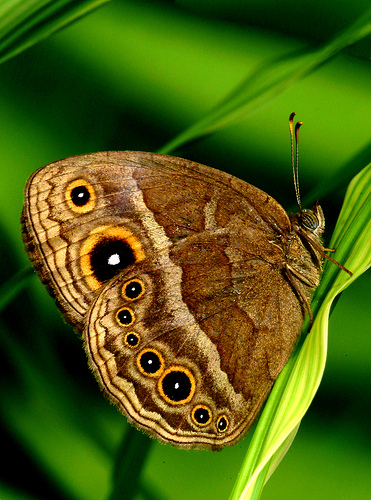
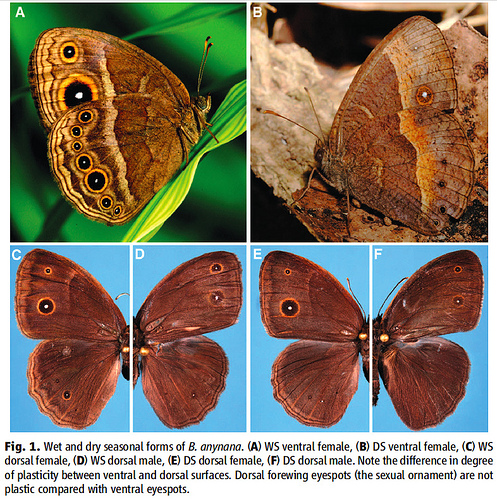


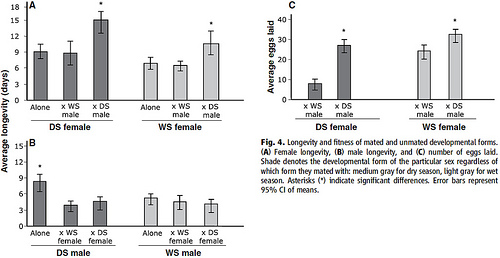
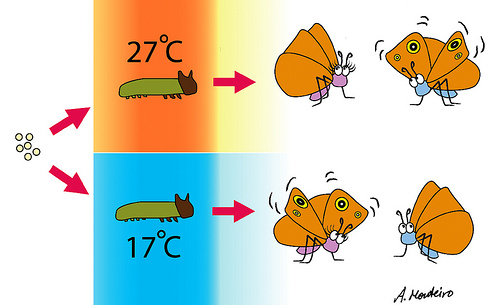
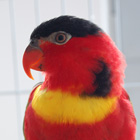












Comments in chronological order (Total 0 comments)
There are no comments yet for this article.